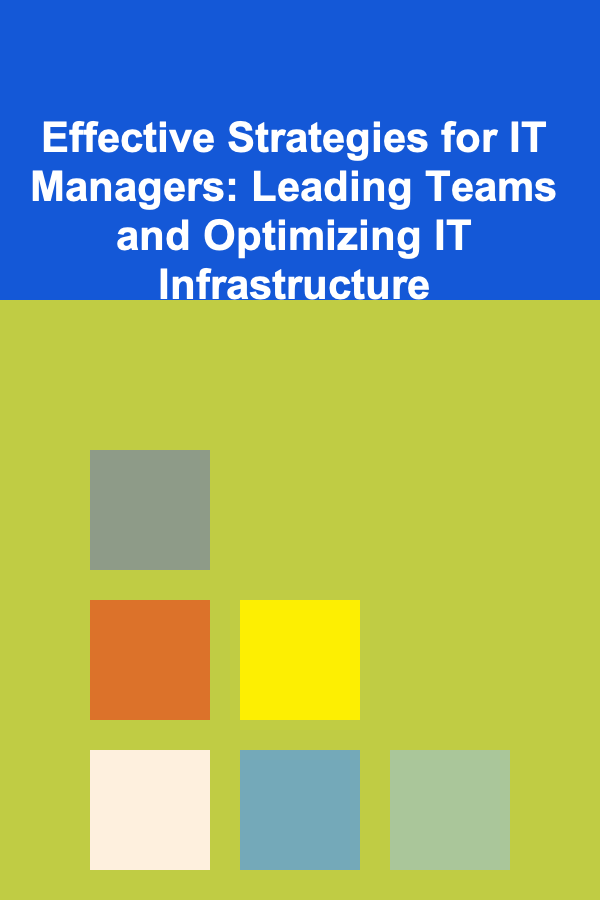
Effective Strategies for IT Managers: Leading Teams and Optimizing IT Infrastructure
ebook include PDF & Audio bundle (Micro Guide)
$12.99$7.99
Limited Time Offer! Order within the next:

In the ever-evolving world of technology, IT managers hold a central role in guiding their teams and optimizing infrastructure to meet organizational goals. With the increasing reliance on digital platforms, cloud solutions, and cybersecurity protocols, IT managers must not only have a deep technical understanding but also possess leadership skills that inspire collaboration, innovation, and efficiency. This guide will delve into actionable strategies for IT managers to lead successful teams and optimize IT infrastructure, ensuring a well-functioning and future-ready technology environment.
Building and Leading High-Performance Teams
At the heart of any successful IT department is a cohesive, skilled, and motivated team. As an IT manager, leading your team effectively involves both technical guidance and emotional intelligence. Here are several strategies to ensure your team thrives:
1.1 Foster a Collaborative Culture
Encouraging open communication and collaboration is essential for building trust within your team. A culture where team members freely share ideas, discuss challenges, and seek feedback leads to better problem-solving and more innovative solutions.
- Promote Cross-functional Collaboration: Foster relationships between your IT team and other departments, such as marketing, sales, and operations. This helps the IT team better understand the needs of other business units and design solutions that align with the broader goals of the organization.
- Encourage Knowledge Sharing: Use platforms like internal wikis, Slack channels, or regular knowledge-sharing sessions to facilitate the exchange of expertise among team members. This not only improves team cohesion but also ensures that critical knowledge is documented and accessible.
- Create a Safe Environment for Experimentation: Innovation thrives in environments where team members feel safe to try new ideas. Encourage experimentation by creating sandboxes, providing access to pilot projects, and rewarding creative problem-solving.
1.2 Provide Clear Direction and Goals
Without clear goals, a team may struggle to stay focused and aligned with the organization's priorities. As an IT manager, it's crucial to set clear, measurable goals and align them with the broader business objectives.
- SMART Goals : Ensure that the goals set for the team are Specific , Measurable , Achievable , Relevant , and Time-bound. This framework helps the team focus on concrete outcomes and enables you to track progress effectively.
- Set Priorities : IT teams often juggle multiple tasks simultaneously. Prioritizing initiatives based on their business value, urgency, and resource availability helps maintain a strategic focus. Use tools like Eisenhower Matrix to categorize tasks as urgent vs. important.
- Align Goals with Business Strategy: Ensure that the technical objectives of your IT team are closely aligned with the company's overarching business goals. This alignment ensures that the team's efforts contribute directly to organizational success.
1.3 Invest in Continuous Learning and Development
The technology landscape is constantly changing. To stay competitive, IT managers must invest in their team's continuous education. This not only enhances team performance but also boosts morale and retention.
- Encourage Certifications and Training: Support team members in obtaining relevant certifications, attending workshops, and participating in webinars. This keeps their skills up to date and ensures the team remains competitive in an ever-changing technological environment.
- Create Mentorship Programs: Senior team members can mentor juniors, passing on valuable knowledge and experience. Mentorship fosters growth within the team and builds leadership capabilities for the future.
- Promote Self-Directed Learning: Encourage team members to take ownership of their learning paths. Provide resources such as online courses, industry conferences, or access to premium content that aligns with their interests and career goals.
Optimizing IT Infrastructure
An optimized IT infrastructure is the backbone of any organization's success. Whether you're handling on-premise systems or transitioning to the cloud, it's essential to ensure that your IT infrastructure is scalable, secure, and efficient.
2.1 Assess and Audit Existing Infrastructure
Before making changes or improvements, it's important to assess the current state of your IT infrastructure. Regular audits allow you to identify areas that need attention, such as obsolete systems, inefficiencies, or potential risks.
- Conduct Regular Infrastructure Audits: These audits should evaluate hardware, software, security protocols, network architecture, and service-level agreements (SLAs). An audit helps identify underutilized resources, outdated technologies, and potential security vulnerabilities.
- Use Monitoring Tools : Implement performance monitoring tools to track the health of systems and networks in real time. Tools like Nagios , Zabbix , or Datadog provide insights into infrastructure performance, enabling proactive maintenance.
2.2 Focus on Scalability
An optimized IT infrastructure should not only meet current demands but also be able to scale as the organization grows. This includes both technical scalability (i.e., handling more data and users) and organizational scalability (i.e., supporting growth without adding undue complexity).
- Adopt Cloud Solutions : Leveraging cloud platforms like AWS , Google Cloud , or Microsoft Azure can dramatically improve scalability. The cloud allows for flexible resource allocation, enabling your organization to scale up or down as needed without investing in costly on-premise hardware.
- Plan for Future Growth : When designing your IT infrastructure, anticipate future needs. For example, adopting microservices architecture, implementing containerization with Docker, or moving to serverless computing can provide the flexibility needed for scaling operations as demand grows.
- Automate Routine Tasks: Automation of repetitive processes---such as software deployment, patch management, and backups---ensures that infrastructure management remains efficient as the system expands.
2.3 Enhance Security and Risk Management
With cyber threats becoming more sophisticated, security must be a top priority. A secure infrastructure not only protects company data but also builds customer trust.
- Implement Layered Security: Employ a multi-layered security approach that includes firewalls, intrusion detection systems, encryption, and access control. Ensure that critical data is encrypted both at rest and in transit.
- Regular Security Audits and Penetration Testing: Conduct regular security audits and hire external firms to perform penetration testing. This will identify vulnerabilities before they can be exploited by malicious actors.
- Create a Disaster Recovery Plan: Develop and regularly test a disaster recovery plan that ensures business continuity in the event of an outage, natural disaster, or cyber attack. The plan should include clear steps for data recovery, system restoration, and communication protocols.
2.4 Optimize Cost Efficiency
While optimizing for performance, it's also essential to consider cost-efficiency. Efficient IT infrastructure management helps control costs while maximizing resource utilization.
- Cloud Cost Optimization : Cloud platforms offer scalability, but they can also lead to overspending if not carefully managed. Use cost management tools like AWS Cost Explorer or Azure Cost Management to track and optimize cloud expenses.
- Consolidate and Virtualize Resources : Consolidate underused physical servers through virtualization technologies like VMware or Hyper-V. This improves resource utilization, reduces overhead, and lowers energy costs.
- Prioritize Green IT: Reducing energy consumption through energy-efficient data centers, server optimization, and virtualization helps lower operational costs and supports sustainability initiatives.
Implementing Best Practices for IT Governance
Effective governance is crucial for ensuring that IT projects align with the strategic goals of the business and that risks are managed appropriately.
3.1 Establish Clear Policies and Procedures
Well-defined policies and procedures ensure consistency, transparency, and accountability. These should govern everything from software development practices to data handling and system access.
- Define IT Governance Frameworks : Implement frameworks such as COBIT or ITIL to ensure that IT processes are aligned with business goals and that risks are effectively managed.
- Set Clear Compliance Guidelines: Ensure that your infrastructure and operations comply with relevant industry regulations (e.g., GDPR, HIPAA, PCI DSS). Regularly update policies to reflect new compliance requirements.
3.2 Measure and Report IT Performance
Regularly measuring and reporting IT performance allows you to assess the effectiveness of your infrastructure and team. Metrics can help identify areas of improvement and inform decision-making.
- Use KPIs to Track Performance: Key performance indicators (KPIs) such as system uptime, ticket resolution time, and incident response times can provide insights into IT efficiency. Align these KPIs with broader organizational objectives.
- Provide Transparent Reporting: Regularly report on IT performance and progress to senior leadership. This transparency helps them understand the impact of IT on the organization and makes it easier to justify investments in IT infrastructure.
Conclusion
Being an effective IT manager goes beyond technical expertise. It involves a combination of strategic thinking, strong leadership, and continuous improvement. By focusing on building a high-performing team, optimizing infrastructure, and implementing best practices for IT governance, you can ensure that your department not only meets current demands but is also prepared for future growth and challenges. Through proactive leadership and a commitment to innovation, IT managers can help their organizations stay ahead of the curve in a rapidly changing technological landscape.

How to Keep Pet Supplies Organized in Your Living Room
Read More
How to Keep Track of Multiple Reservations and Bookings
Read More
How to Make Money Online as a Freelance Writer: 10 Actionable Ideas
Read More
How to Plan a Family Outdoor Adventure in Your Backyard
Read More
How to Set Up Outdoor Lighting for a Welcoming Patio or Garden
Read More
Saving Money on Beauty and Grooming Services: Tricks for Gorgeous Results on a Budget
Read MoreOther Products

How to Keep Pet Supplies Organized in Your Living Room
Read More
How to Keep Track of Multiple Reservations and Bookings
Read More
How to Make Money Online as a Freelance Writer: 10 Actionable Ideas
Read More
How to Plan a Family Outdoor Adventure in Your Backyard
Read More
How to Set Up Outdoor Lighting for a Welcoming Patio or Garden
Read More